check oil BMW 5 SERIES ACTIVE HYBRID 2015 Owners Manual
[x] Cancel search | Manufacturer: BMW, Model Year: 2015, Model line: 5 SERIES ACTIVE HYBRID, Model: BMW 5 SERIES ACTIVE HYBRID 2015Pages: 257, PDF Size: 5.26 MB
Page 91 of 257
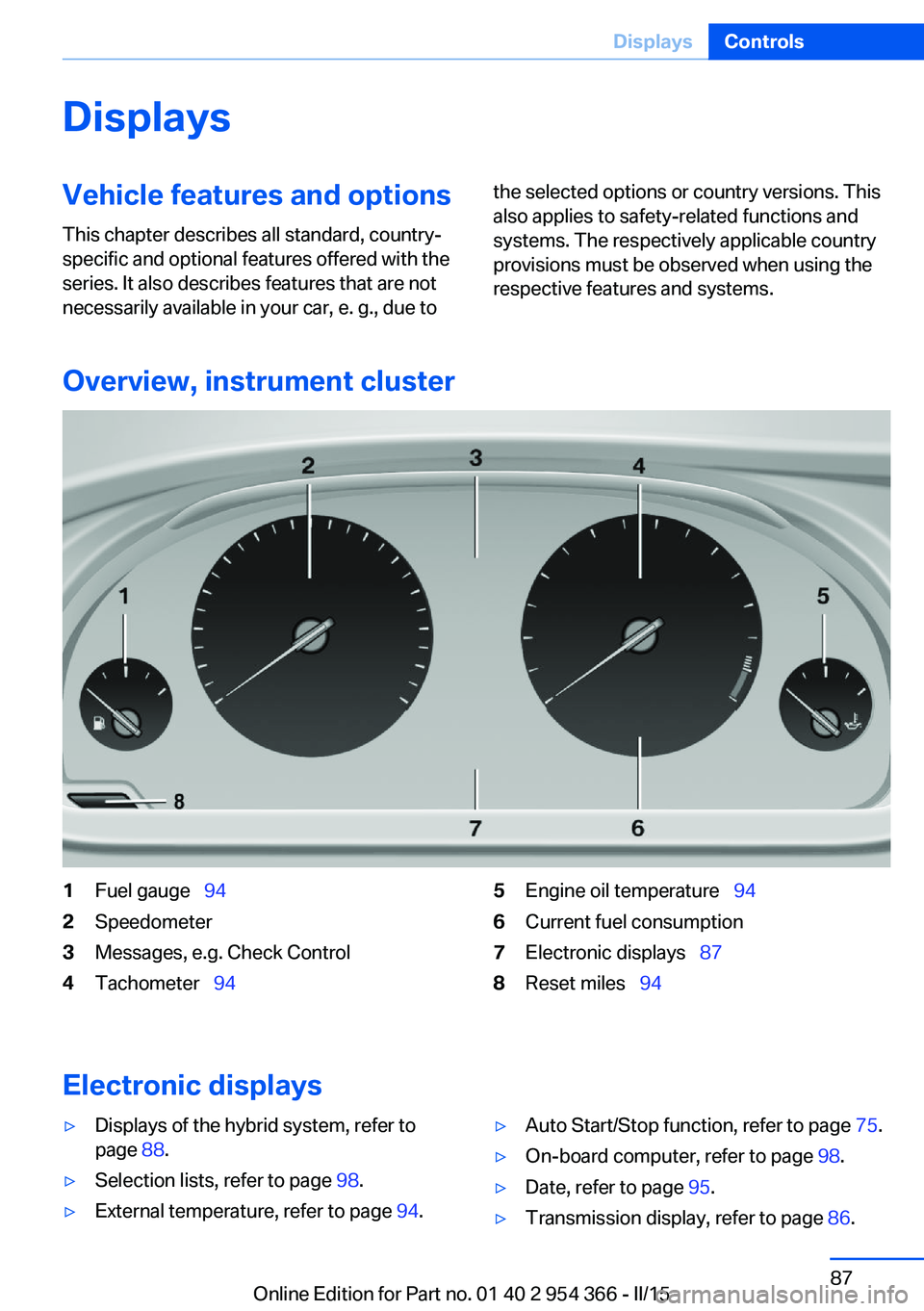
DisplaysVehicle features and optionsThis chapter describes all standard, country-
specific and optional features offered with the
series. It also describes features that are not
necessarily available in your car, e. g., due tothe selected options or country versions. This
also applies to safety-related functions and
systems. The respectively applicable country
provisions must be observed when using the
respective features and systems.
Overview, instrument cluster
1Fuel gauge 942Speedometer3Messages, e.g. Check Control4Tachometer 945Engine oil temperature 946Current fuel consumption7Electronic displays 878Reset miles 94
Electronic displays
▷Displays of the hybrid system, refer to
page 88.▷Selection lists, refer to page 98.▷External temperature, refer to page 94.▷Auto Start/Stop function, refer to page 75.▷On-board computer, refer to page 98.▷Date, refer to page 95.▷Transmission display, refer to page 86.Seite 87DisplaysControls87
Online Edition for Part no. 01 40 2 954 366 - II/15
Page 98 of 257
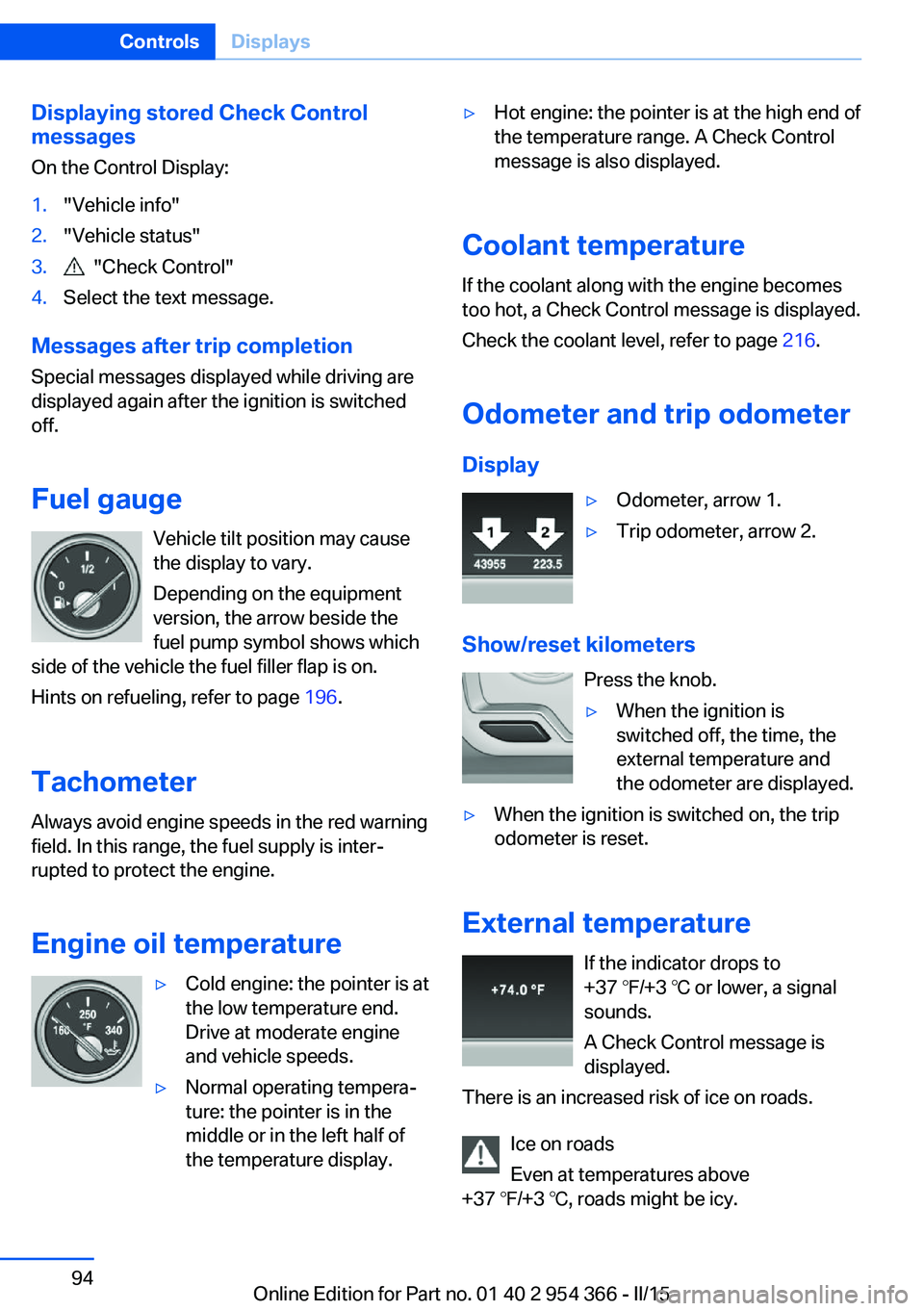
Displaying stored Check Control
messages
On the Control Display:1."Vehicle info"2."Vehicle status"3. "Check Control"4.Select the text message.
Messages after trip completion Special messages displayed while driving are
displayed again after the ignition is switched
off.
Fuel gauge Vehicle tilt position may cause
the display to vary.
Depending on the equipment
version, the arrow beside the
fuel pump symbol shows which
side of the vehicle the fuel filler flap is on.
Hints on refueling, refer to page 196.
Tachometer Always avoid engine speeds in the red warning
field. In this range, the fuel supply is inter‐
rupted to protect the engine.
Engine oil temperature
▷Cold engine: the pointer is at
the low temperature end.
Drive at moderate engine
and vehicle speeds.▷Normal operating tempera‐
ture: the pointer is in the
middle or in the left half of
the temperature display.▷Hot engine: the pointer is at the high end of
the temperature range. A Check Control
message is also displayed.
Coolant temperature
If the coolant along with the engine becomes
too hot, a Check Control message is displayed.
Check the coolant level, refer to page 216.
Odometer and trip odometer Display
▷Odometer, arrow 1.▷Trip odometer, arrow 2.
Show/reset kilometers Press the knob.
▷When the ignition is
switched off, the time, the
external temperature and
the odometer are displayed.▷When the ignition is switched on, the trip
odometer is reset.
External temperature
If the indicator drops to
+37 ℉/+3 ℃ or lower, a signal
sounds.
A Check Control message is displayed.
There is an increased risk of ice on roads.
Ice on roads
Even at temperatures above
+37 ℉/+3 ℃, roads might be icy.
Seite 94ControlsDisplays94
Online Edition for Part no. 01 40 2 954 366 - II/15
Page 210 of 257
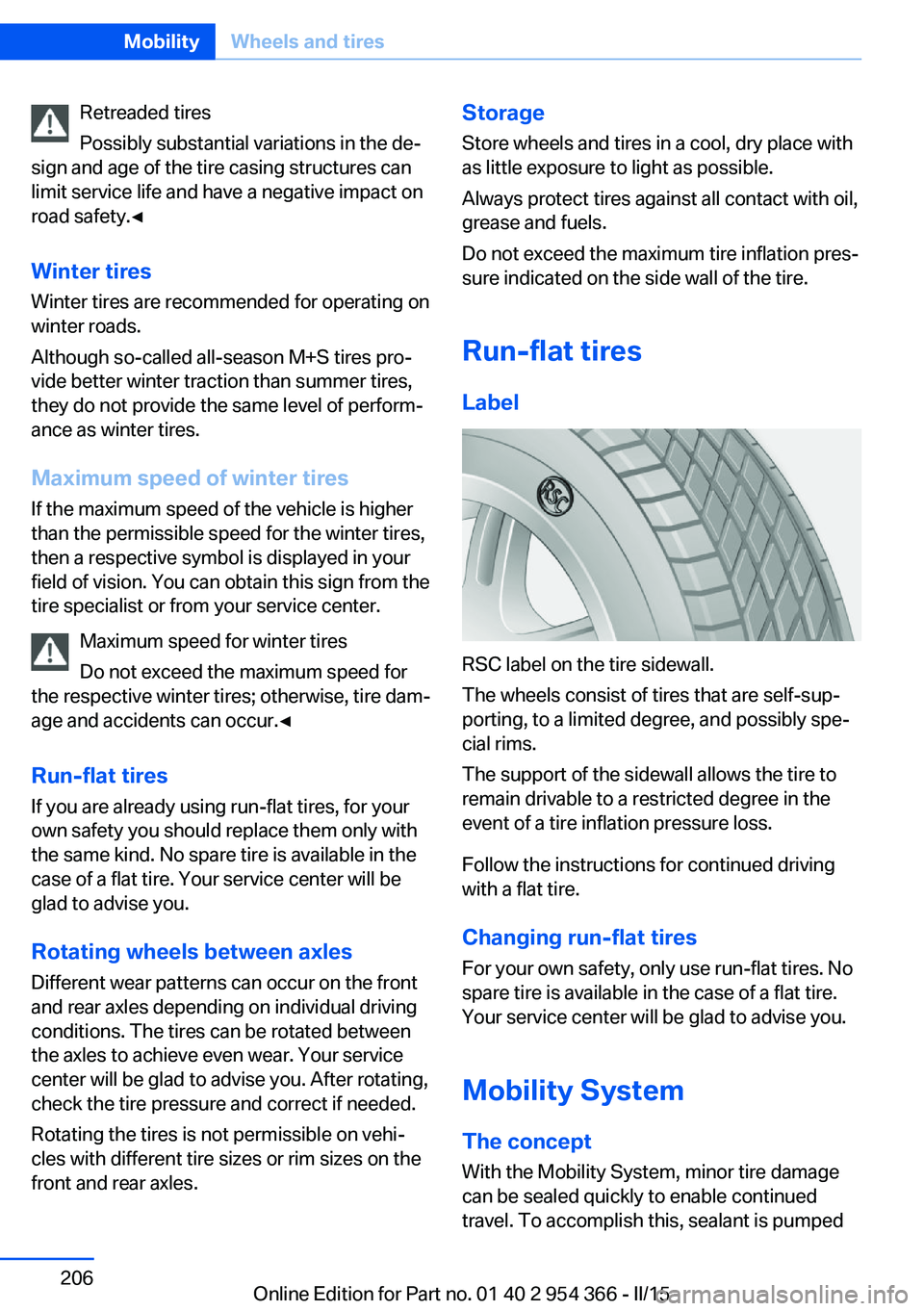
Retreaded tires
Possibly substantial variations in the de‐
sign and age of the tire casing structures can
limit service life and have a negative impact on
road safety.◀
Winter tires
Winter tires are recommended for operating on
winter roads.
Although so-called all-season M+S tires pro‐
vide better winter traction than summer tires, they do not provide the same level of perform‐
ance as winter tires.
Maximum speed of winter tires If the maximum speed of the vehicle is higher
than the permissible speed for the winter tires,
then a respective symbol is displayed in your
field of vision. You can obtain this sign from the
tire specialist or from your service center.
Maximum speed for winter tires
Do not exceed the maximum speed for
the respective winter tires; otherwise, tire dam‐
age and accidents can occur.◀
Run-flat tires If you are already using run-flat tires, for your
own safety you should replace them only with
the same kind. No spare tire is available in the
case of a flat tire. Your service center will be
glad to advise you.
Rotating wheels between axlesDifferent wear patterns can occur on the frontand rear axles depending on individual driving
conditions. The tires can be rotated between
the axles to achieve even wear. Your service
center will be glad to advise you. After rotating,
check the tire pressure and correct if needed.
Rotating the tires is not permissible on vehi‐
cles with different tire sizes or rim sizes on the
front and rear axles.Storage
Store wheels and tires in a cool, dry place with
as little exposure to light as possible.
Always protect tires against all contact with oil,
grease and fuels.
Do not exceed the maximum tire inflation pres‐
sure indicated on the side wall of the tire.
Run-flat tires Label
RSC label on the tire sidewall.
The wheels consist of tires that are self-sup‐
porting, to a limited degree, and possibly spe‐
cial rims.
The support of the sidewall allows the tire to
remain drivable to a restricted degree in the
event of a tire inflation pressure loss.
Follow the instructions for continued driving
with a flat tire.
Changing run-flat tires
For your own safety, only use run-flat tires. No
spare tire is available in the case of a flat tire.
Your service center will be glad to advise you.
Mobility System
The concept With the Mobility System, minor tire damagecan be sealed quickly to enable continued
travel. To accomplish this, sealant is pumped
Seite 206MobilityWheels and tires206
Online Edition for Part no. 01 40 2 954 366 - II/15
Page 217 of 257
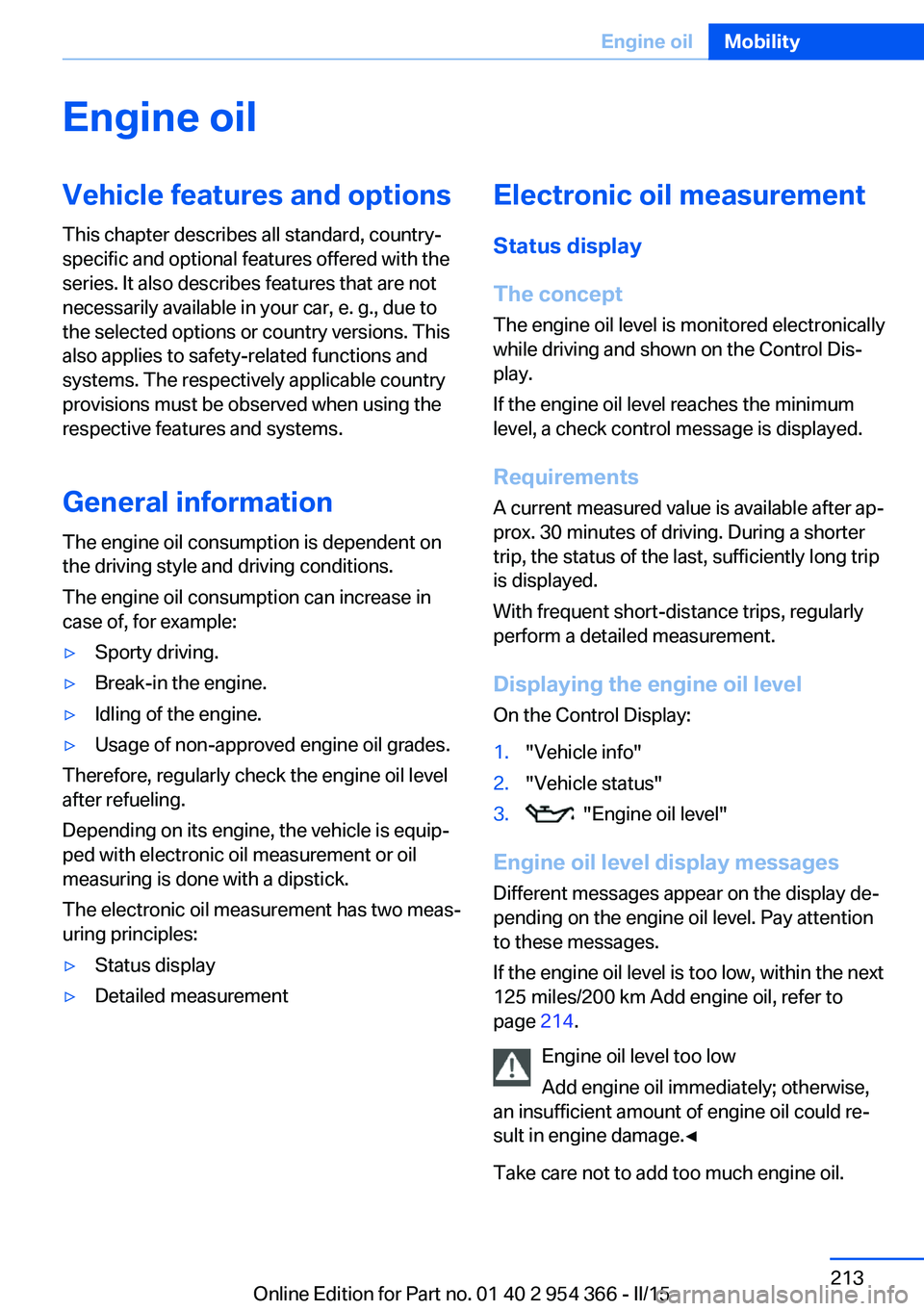
Engine oilVehicle features and options
This chapter describes all standard, country-
specific and optional features offered with the
series. It also describes features that are not
necessarily available in your car, e. g., due to
the selected options or country versions. This
also applies to safety-related functions and
systems. The respectively applicable country
provisions must be observed when using the
respective features and systems.
General information The engine oil consumption is dependent on
the driving style and driving conditions.
The engine oil consumption can increase in
case of, for example:▷Sporty driving.▷Break-in the engine.▷Idling of the engine.▷Usage of non-approved engine oil grades.
Therefore, regularly check the engine oil level
after refueling.
Depending on its engine, the vehicle is equip‐
ped with electronic oil measurement or oil
measuring is done with a dipstick.
The electronic oil measurement has two meas‐
uring principles:
▷Status display▷Detailed measurementElectronic oil measurement
Status display
The concept
The engine oil level is monitored electronically
while driving and shown on the Control Dis‐
play.
If the engine oil level reaches the minimum
level, a check control message is displayed.
Requirements
A current measured value is available after ap‐
prox. 30 minutes of driving. During a shorter
trip, the status of the last, sufficiently long trip
is displayed.
With frequent short-distance trips, regularly
perform a detailed measurement.
Displaying the engine oil level
On the Control Display:1."Vehicle info"2."Vehicle status"3. "Engine oil level"
Engine oil level display messages
Different messages appear on the display de‐
pending on the engine oil level. Pay attention
to these messages.
If the engine oil level is too low, within the next
125 miles/200 km Add engine oil, refer to
page 214.
Engine oil level too low
Add engine oil immediately; otherwise,
an insufficient amount of engine oil could re‐
sult in engine damage.◀
Take care not to add too much engine oil.
Seite 213Engine oilMobility213
Online Edition for Part no. 01 40 2 954 366 - II/15
Page 218 of 257
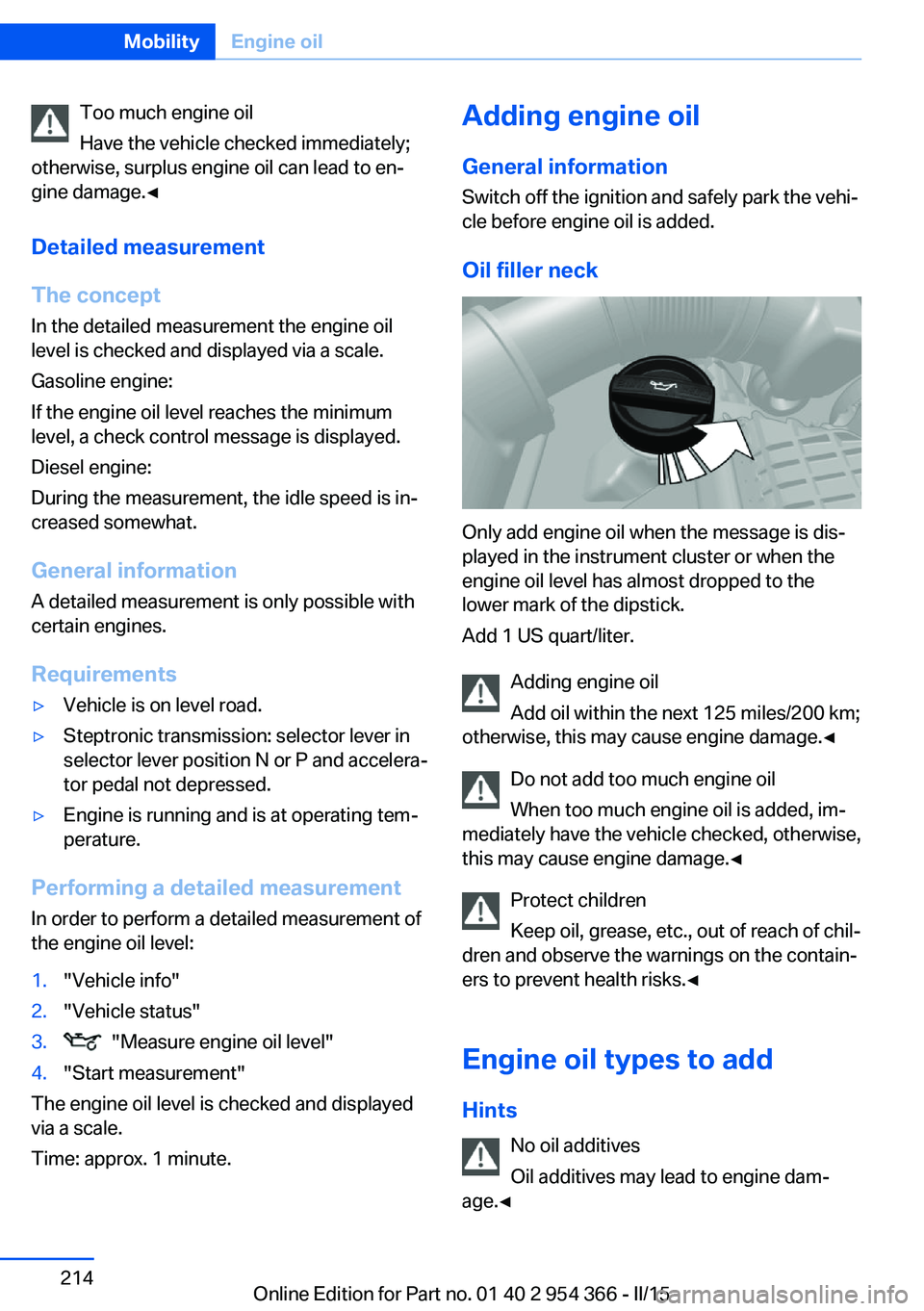
Too much engine oil
Have the vehicle checked immediately;
otherwise, surplus engine oil can lead to en‐
gine damage.◀
Detailed measurement
The concept In the detailed measurement the engine oil
level is checked and displayed via a scale.
Gasoline engine:
If the engine oil level reaches the minimum
level, a check control message is displayed.
Diesel engine:
During the measurement, the idle speed is in‐
creased somewhat.
General information A detailed measurement is only possible with
certain engines.
Requirements▷Vehicle is on level road.▷Steptronic transmission: selector lever in
selector lever position N or P and accelera‐
tor pedal not depressed.▷Engine is running and is at operating tem‐
perature.
Performing a detailed measurement
In order to perform a detailed measurement of
the engine oil level:
1."Vehicle info"2."Vehicle status"3. "Measure engine oil level"4."Start measurement"
The engine oil level is checked and displayed
via a scale.
Time: approx. 1 minute.
Adding engine oil
General information
Switch off the ignition and safely park the vehi‐
cle before engine oil is added.
Oil filler neck
Only add engine oil when the message is dis‐
played in the instrument cluster or when the
engine oil level has almost dropped to the
lower mark of the dipstick.
Add 1 US quart/liter.
Adding engine oil
Add oil within the next 125 miles/200 km;
otherwise, this may cause engine damage.◀
Do not add too much engine oil
When too much engine oil is added, im‐
mediately have the vehicle checked, otherwise,
this may cause engine damage.◀
Protect children
Keep oil, grease, etc., out of reach of chil‐
dren and observe the warnings on the contain‐
ers to prevent health risks.◀
Engine oil types to add Hints No oil additives
Oil additives may lead to engine dam‐
age.◀
Seite 214MobilityEngine oil214
Online Edition for Part no. 01 40 2 954 366 - II/15
Page 222 of 257
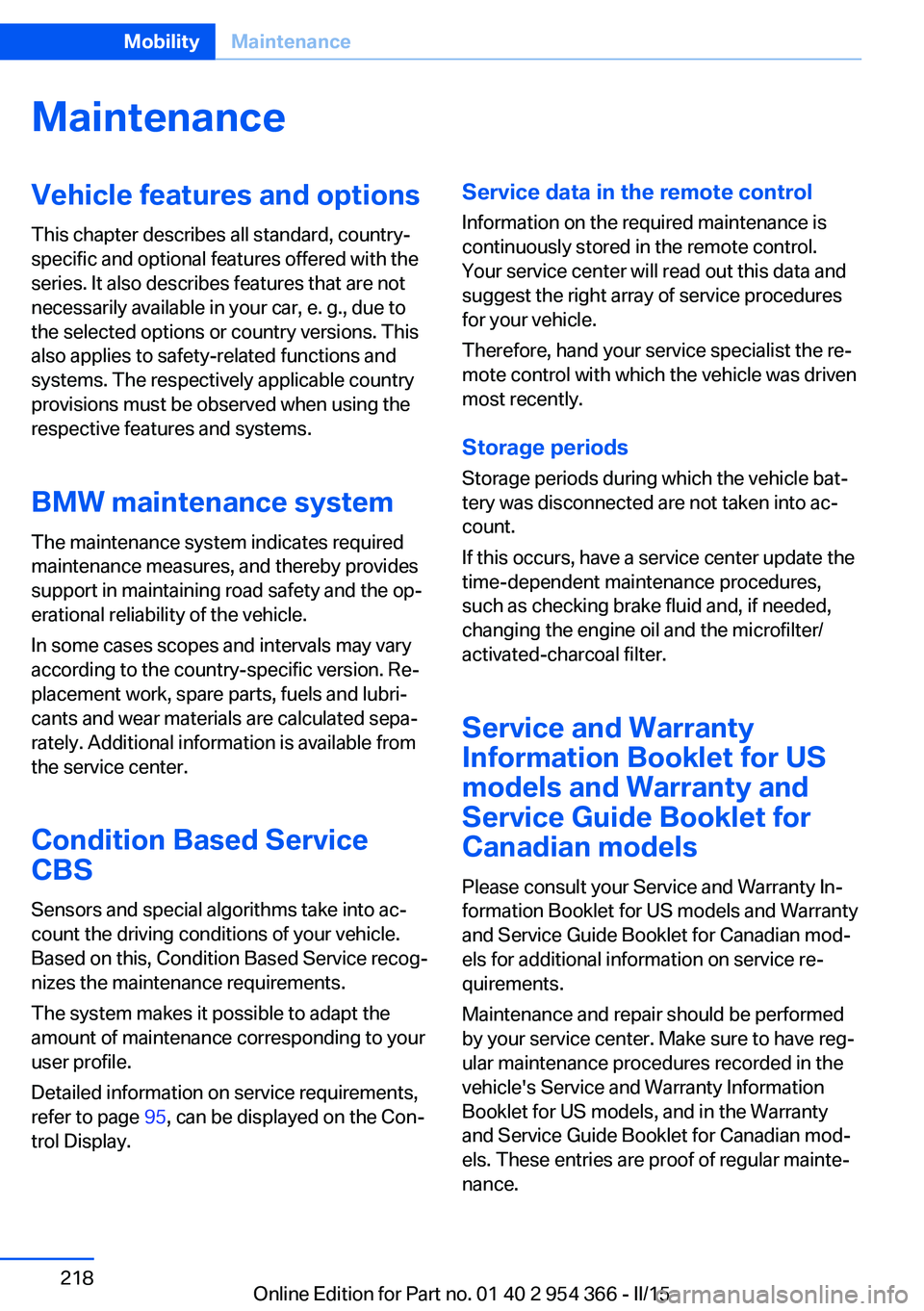
MaintenanceVehicle features and options
This chapter describes all standard, country-
specific and optional features offered with the
series. It also describes features that are not
necessarily available in your car, e. g., due to
the selected options or country versions. This
also applies to safety-related functions and
systems. The respectively applicable country
provisions must be observed when using the
respective features and systems.
BMW maintenance system The maintenance system indicates required
maintenance measures, and thereby provides
support in maintaining road safety and the op‐
erational reliability of the vehicle.
In some cases scopes and intervals may vary
according to the country-specific version. Re‐
placement work, spare parts, fuels and lubri‐
cants and wear materials are calculated sepa‐
rately. Additional information is available from
the service center.
Condition Based Service
CBS
Sensors and special algorithms take into ac‐
count the driving conditions of your vehicle.
Based on this, Condition Based Service recog‐
nizes the maintenance requirements.
The system makes it possible to adapt the
amount of maintenance corresponding to your
user profile.
Detailed information on service requirements,
refer to page 95, can be displayed on the Con‐
trol Display.Service data in the remote control
Information on the required maintenance is
continuously stored in the remote control. Your service center will read out this data and
suggest the right array of service procedures for your vehicle.
Therefore, hand your service specialist the re‐
mote control with which the vehicle was driven
most recently.
Storage periods Storage periods during which the vehicle bat‐
tery was disconnected are not taken into ac‐
count.
If this occurs, have a service center update the
time-dependent maintenance procedures,
such as checking brake fluid and, if needed,
changing the engine oil and the microfilter/
activated-charcoal filter.
Service and Warranty
Information Booklet for US
models and Warranty and
Service Guide Booklet for
Canadian models
Please consult your Service and Warranty In‐
formation Booklet for US models and Warranty
and Service Guide Booklet for Canadian mod‐
els for additional information on service re‐
quirements.
Maintenance and repair should be performed
by your service center. Make sure to have reg‐
ular maintenance procedures recorded in the
vehicle's Service and Warranty Information
Booklet for US models, and in the Warranty
and Service Guide Booklet for Canadian mod‐
els. These entries are proof of regular mainte‐
nance.Seite 218MobilityMaintenance218
Online Edition for Part no. 01 40 2 954 366 - II/15
Page 238 of 257
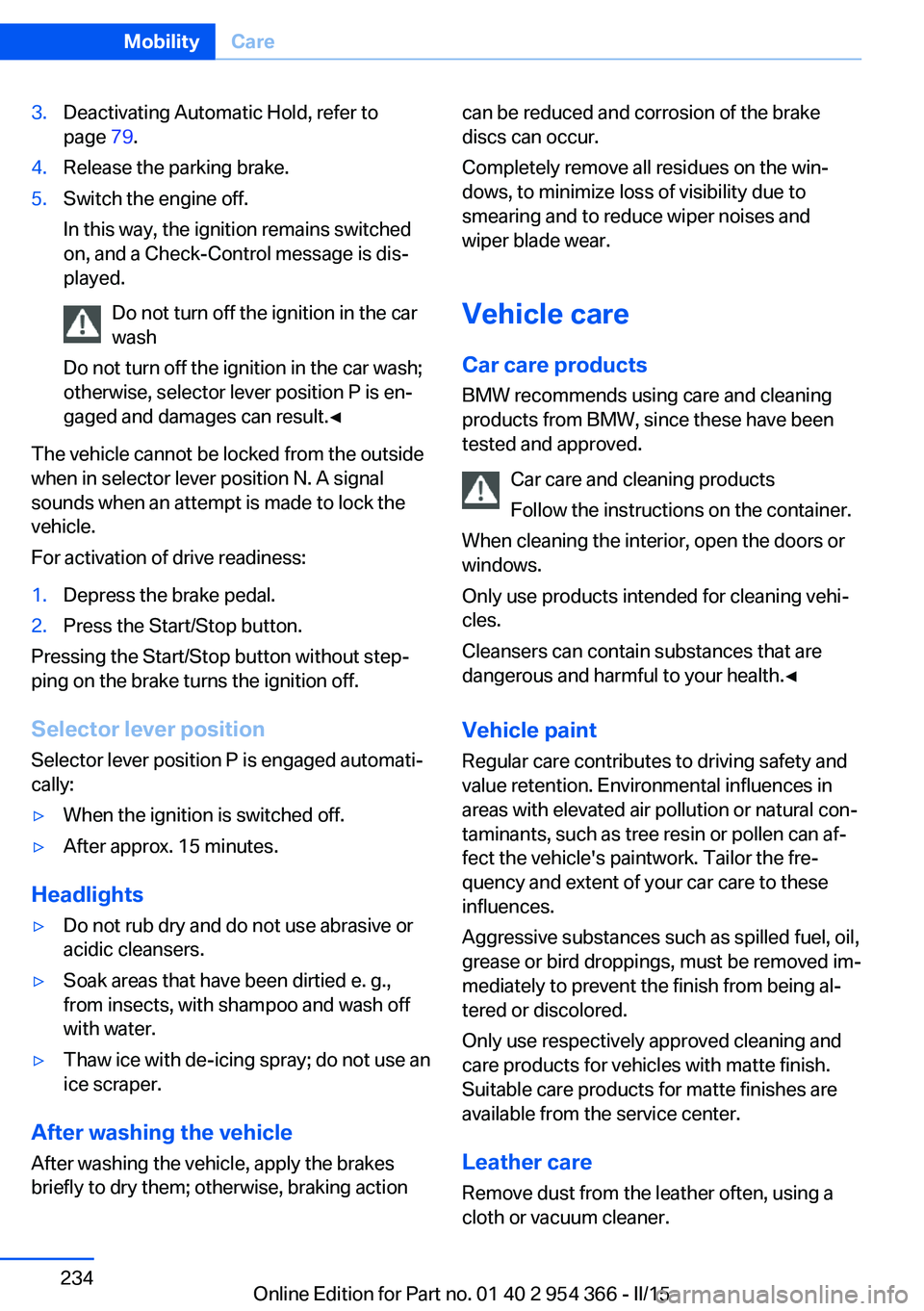
3.Deactivating Automatic Hold, refer to
page 79.4.Release the parking brake.5.Switch the engine off.
In this way, the ignition remains switched
on, and a Check-Control message is dis‐
played.
Do not turn off the ignition in the car
wash
Do not turn off the ignition in the car wash;
otherwise, selector lever position P is en‐
gaged and damages can result.◀
The vehicle cannot be locked from the outside
when in selector lever position N. A signal
sounds when an attempt is made to lock the
vehicle.
For activation of drive readiness:
1.Depress the brake pedal.2.Press the Start/Stop button.
Pressing the Start/Stop button without step‐
ping on the brake turns the ignition off.
Selector lever positionSelector lever position P is engaged automati‐
cally:
▷When the ignition is switched off.▷After approx. 15 minutes.
Headlights
▷Do not rub dry and do not use abrasive or
acidic cleansers.▷Soak areas that have been dirtied e. g.,
from insects, with shampoo and wash off
with water.▷Thaw ice with de-icing spray; do not use an
ice scraper.
After washing the vehicle
After washing the vehicle, apply the brakes
briefly to dry them; otherwise, braking action
can be reduced and corrosion of the brake
discs can occur.
Completely remove all residues on the win‐
dows, to minimize loss of visibility due to
smearing and to reduce wiper noises and
wiper blade wear.
Vehicle care
Car care products BMW recommends using care and cleaning
products from BMW, since these have been
tested and approved.
Car care and cleaning products
Follow the instructions on the container.
When cleaning the interior, open the doors or
windows.
Only use products intended for cleaning vehi‐
cles.
Cleansers can contain substances that are
dangerous and harmful to your health.◀
Vehicle paint
Regular care contributes to driving safety and
value retention. Environmental influences in
areas with elevated air pollution or natural con‐
taminants, such as tree resin or pollen can af‐
fect the vehicle's paintwork. Tailor the fre‐
quency and extent of your car care to these
influences.
Aggressive substances such as spilled fuel, oil,
grease or bird droppings, must be removed im‐
mediately to prevent the finish from being al‐
tered or discolored.
Only use respectively approved cleaning and
care products for vehicles with matte finish.
Suitable care products for matte finishes are
available from the service center.
Leather care
Remove dust from the leather often, using a
cloth or vacuum cleaner.Seite 234MobilityCare234
Online Edition for Part no. 01 40 2 954 366 - II/15
Page 247 of 257
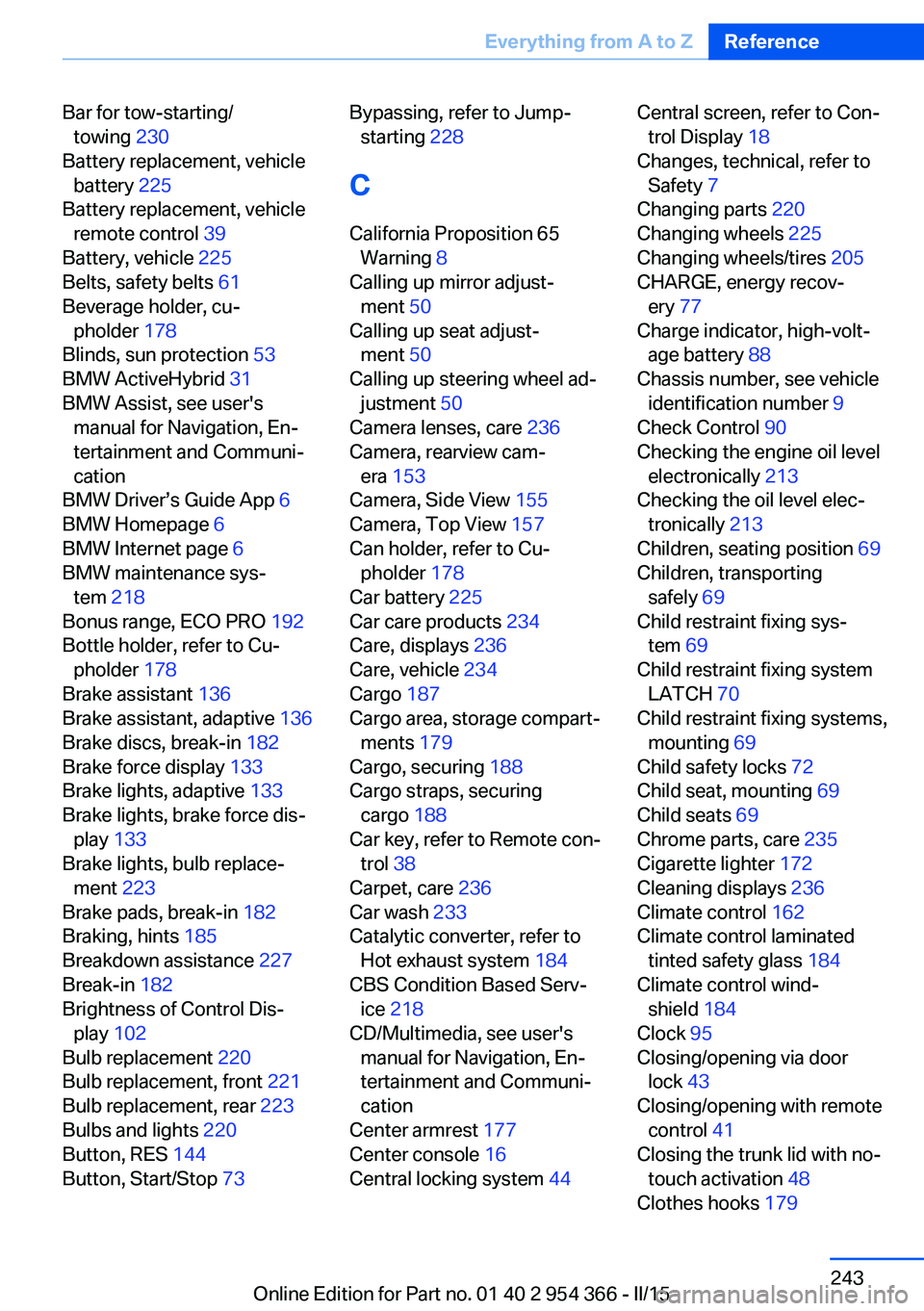
Bar for tow-starting/towing 230
Battery replacement, vehicle battery 225
Battery replacement, vehicle remote control 39
Battery, vehicle 225
Belts, safety belts 61
Beverage holder, cu‐ pholder 178
Blinds, sun protection 53
BMW ActiveHybrid 31
BMW Assist, see user's manual for Navigation, En‐
tertainment and Communi‐
cation
BMW Driver’s Guide App 6
BMW Homepage 6
BMW Internet page 6
BMW maintenance sys‐ tem 218
Bonus range, ECO PRO 192
Bottle holder, refer to Cu‐ pholder 178
Brake assistant 136
Brake assistant, adaptive 136
Brake discs, break-in 182
Brake force display 133
Brake lights, adaptive 133
Brake lights, brake force dis‐ play 133
Brake lights, bulb replace‐ ment 223
Brake pads, break-in 182
Braking, hints 185
Breakdown assistance 227
Break-in 182
Brightness of Control Dis‐ play 102
Bulb replacement 220
Bulb replacement, front 221
Bulb replacement, rear 223
Bulbs and lights 220
Button, RES 144
Button, Start/Stop 73 Bypassing, refer to Jump-
starting 228
C
California Proposition 65 Warning 8
Calling up mirror adjust‐ ment 50
Calling up seat adjust‐ ment 50
Calling up steering wheel ad‐ justment 50
Camera lenses, care 236
Camera, rearview cam‐ era 153
Camera, Side View 155
Camera, Top View 157
Can holder, refer to Cu‐ pholder 178
Car battery 225
Car care products 234
Care, displays 236
Care, vehicle 234
Cargo 187
Cargo area, storage compart‐ ments 179
Cargo, securing 188
Cargo straps, securing cargo 188
Car key, refer to Remote con‐ trol 38
Carpet, care 236
Car wash 233
Catalytic converter, refer to Hot exhaust system 184
CBS Condition Based Serv‐ ice 218
CD/Multimedia, see user's manual for Navigation, En‐
tertainment and Communi‐
cation
Center armrest 177
Center console 16
Central locking system 44 Central screen, refer to Con‐
trol Display 18
Changes, technical, refer to Safety 7
Changing parts 220
Changing wheels 225
Changing wheels/tires 205
CHARGE, energy recov‐ ery 77
Charge indicator, high-volt‐ age battery 88
Chassis number, see vehicle identification number 9
Check Control 90
Checking the engine oil level electronically 213
Checking the oil level elec‐ tronically 213
Children, seating position 69
Children, transporting safely 69
Child restraint fixing sys‐ tem 69
Child restraint fixing system LATCH 70
Child restraint fixing systems, mounting 69
Child safety locks 72
Child seat, mounting 69
Child seats 69
Chrome parts, care 235
Cigarette lighter 172
Cleaning displays 236
Climate control 162
Climate control laminated tinted safety glass 184
Climate control wind‐ shield 184
Clock 95
Closing/opening via door lock 43
Closing/opening with remote control 41
Closing the trunk lid with no- touch activation 48
Clothes hooks 179 Seite 243Everything from A to ZReference243
Online Edition for Part no. 01 40 2 954 366 - II/15
Page 249 of 257
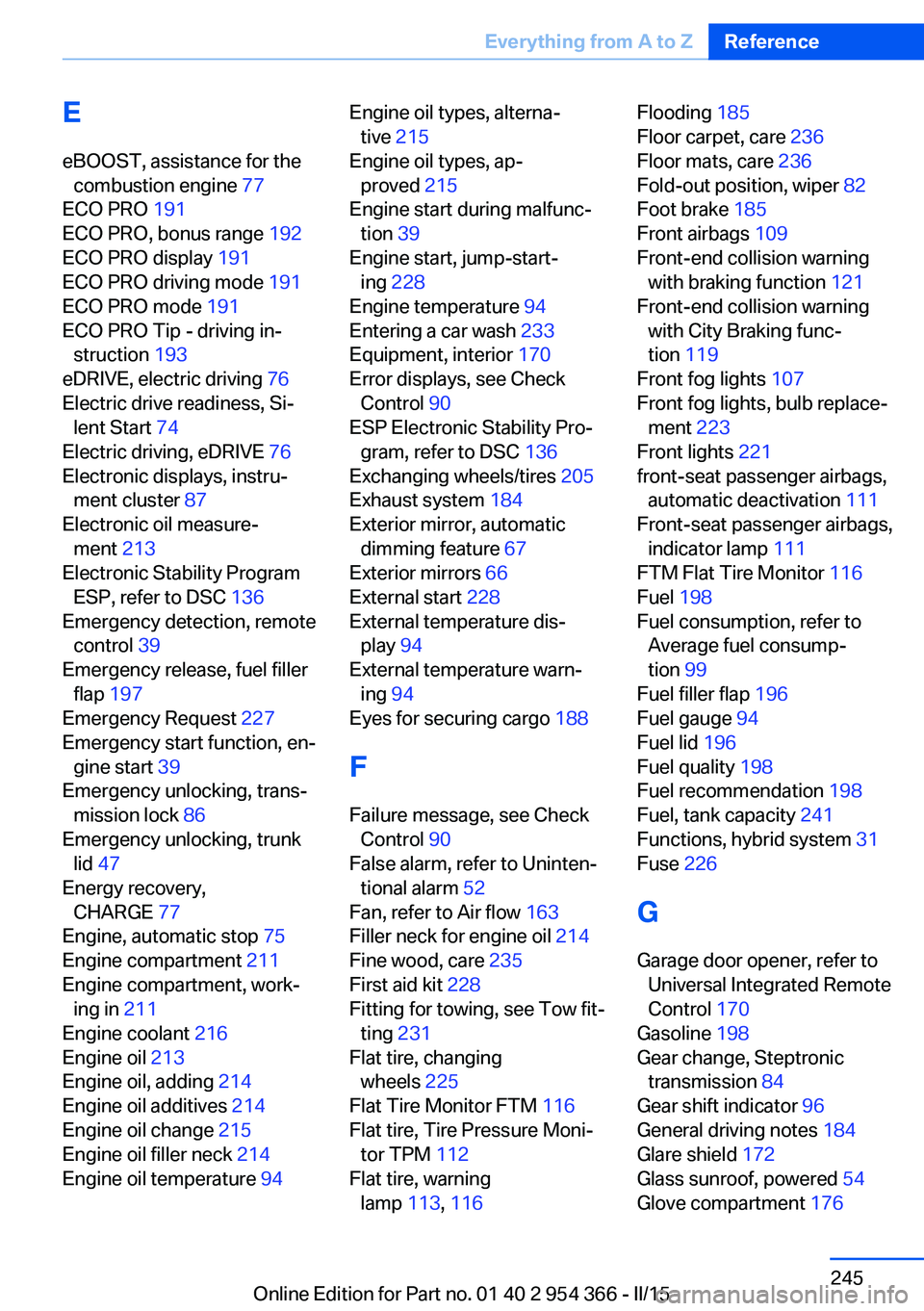
EeBOOST, assistance for the combustion engine 77
ECO PRO 191
ECO PRO, bonus range 192
ECO PRO display 191
ECO PRO driving mode 191
ECO PRO mode 191
ECO PRO Tip - driving in‐ struction 193
eDRIVE, electric driving 76
Electric drive readiness, Si‐ lent Start 74
Electric driving, eDRIVE 76
Electronic displays, instru‐ ment cluster 87
Electronic oil measure‐ ment 213
Electronic Stability Program ESP, refer to DSC 136
Emergency detection, remote control 39
Emergency release, fuel filler flap 197
Emergency Request 227
Emergency start function, en‐ gine start 39
Emergency unlocking, trans‐ mission lock 86
Emergency unlocking, trunk lid 47
Energy recovery, CHARGE 77
Engine, automatic stop 75
Engine compartment 211
Engine compartment, work‐ ing in 211
Engine coolant 216
Engine oil 213
Engine oil, adding 214
Engine oil additives 214
Engine oil change 215
Engine oil filler neck 214
Engine oil temperature 94 Engine oil types, alterna‐
tive 215
Engine oil types, ap‐ proved 215
Engine start during malfunc‐ tion 39
Engine start, jump-start‐ ing 228
Engine temperature 94
Entering a car wash 233
Equipment, interior 170
Error displays, see Check Control 90
ESP Electronic Stability Pro‐ gram, refer to DSC 136
Exchanging wheels/tires 205
Exhaust system 184
Exterior mirror, automatic dimming feature 67
Exterior mirrors 66
External start 228
External temperature dis‐ play 94
External temperature warn‐ ing 94
Eyes for securing cargo 188
F
Failure message, see Check Control 90
False alarm, refer to Uninten‐ tional alarm 52
Fan, refer to Air flow 163
Filler neck for engine oil 214
Fine wood, care 235
First aid kit 228
Fitting for towing, see Tow fit‐ ting 231
Flat tire, changing wheels 225
Flat Tire Monitor FTM 116
Flat tire, Tire Pressure Moni‐ tor TPM 112
Flat tire, warning lamp 113, 116 Flooding 185
Floor carpet, care 236
Floor mats, care 236
Fold-out position, wiper 82
Foot brake 185
Front airbags 109
Front-end collision warning with braking function 121
Front-end collision warning with City Braking func‐
tion 119
Front fog lights 107
Front fog lights, bulb replace‐ ment 223
Front lights 221
front-seat passenger airbags, automatic deactivation 111
Front-seat passenger airbags, indicator lamp 111
FTM Flat Tire Monitor 116
Fuel 198
Fuel consumption, refer to Average fuel consump‐
tion 99
Fuel filler flap 196
Fuel gauge 94
Fuel lid 196
Fuel quality 198
Fuel recommendation 198
Fuel, tank capacity 241
Functions, hybrid system 31
Fuse 226
G
Garage door opener, refer to Universal Integrated Remote
Control 170
Gasoline 198
Gear change, Steptronic transmission 84
Gear shift indicator 96
General driving notes 184
Glare shield 172
Glass sunroof, powered 54
Glove compartment 176 Seite 245Everything from A to ZReference245
Online Edition for Part no. 01 40 2 954 366 - II/15